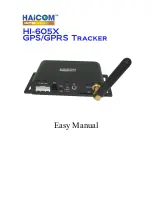
PCM-3291
1
USER MENU
1.GPS INTRODUCTION
GPS is fully operational and meets the criteria established in the 1960s for an
optimum positioning system. The system provides accurate, continuous , worldwide
, three-dimensional position and velocity information to users with the appropriate
receiving equipment. GPS also disseminates a form of Universal Time Coordinated
(UTC). The satellite constellation consists of 24 satellites arranged in 6 orbital planes
with 4 satellites per plane. A worldwide ground control/monitoring network monitors
the health and status of the satellites. This network also uploads navigation and other
data to the satellites. GPS can provide service to an unlimited number of users since
the user receivers operate passively(i.e., receive only). The system utilizes the concept
of one-way Time Of Arrival (TOA) ranging. Satellite transmissions are referenced to
highly accurate atomic frequency standards onboard the satellites, which are in
synchronism with an internal GPS system time base. The satellites broadcast ranging
codes and navigation data on two frequencies using a technique called Code Division
Multiple Access (CDMA); that is, there are only two frequencies in use by the system,
called L1 (1575.42MHz) and L2 (1227.6MHz). Each satellite transmits on these
frequencies, but with different ranging codes than those employed by other satellites.
These codes were selected because they have low cross-correlation properties with
respect to one another. The navigation data provides the means for the receiver to
determine the location of the satellite at the time of signal transmission, whereas the
ranging code enables the user’s receiver to determine the transit (i.e., propagation)
time of the signal and thereby determine the satellite-to-user range. This technique
requires that the user receiver also contain a clock. Utilizing this technique to measure
the receiver’s three-dimensional location requires that TOA ranging measurements be
made to four satellites. If the receiver clock was synchronized with the satellite clocks
, only three range measurements would be required. However, a crystal clock is
usually employed in navigation receivers to minimize the cost, complexity, and size of
the receiver. Thus, four measurements are required to determine user latitude,
longitude, height, and receiver clock offset from internal system time. If either system
time or altitude is accurately known, less than four satellites are required. GPS
provides two services : the Standard Positioning Service (SPS) and the Precise
Positioning Service (PPS). The SPS is designated for the civil community, whereas
the PPS is slated for U.S. authorized military and select government agency users.
Access to the GPS PPS is controlled through cryptography.
Summary of Contents for PCM-3291
Page 1: ...PCM 3291 USER MANUAL ...






























